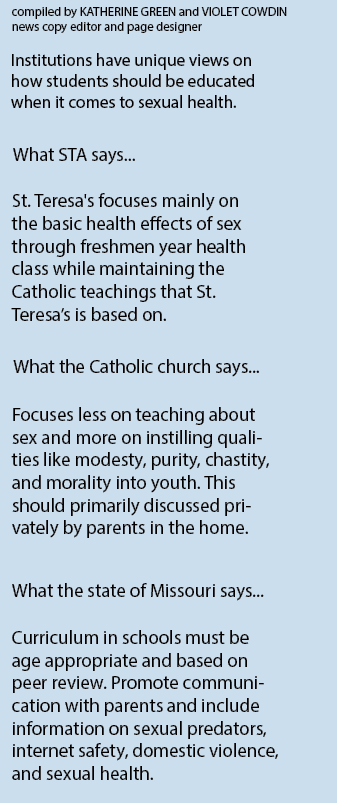Catholic teaching and sex ed
Sexual education continues to be a sensitive issue since the school has to have it within the Catholic Teachings.
February 9, 2016

photo courtesy of The New York Times
Walking into PE class during her second semester of freshman year sophomore Julia Mantel got a nervous feeling. This semester was explored the health portion of the class and students would have to discuss different STDs and drugs. Although Mantel felt awkward about the different STD she was being taught, she and her friends figured it would be less uncomfortable if they could laugh about the different subjects and not take them as seriously. According to Mantel, almost all the students in class would quietly giggle as different STDs and drugs were presented individually by each freshman.
Although Mantel goofed off during health class freshman year, she feels that a class like that now would be much more relevant to her life.
“As a freshman, I never thought about any of that stuff happening to me,” Mantel said. “But being older, it would be more helpful because we can be put in these kind of situations more than as a freshman.”
Students at STA must take the required General Physical Education and Health class as freshmen. In this class, teacher Stacie O’Rear begins first semester with various games and sports for the students to play, including eclipse ball and ultimate frisbee. During the second semester, O’Rear teaches her students about different topics involving sexual and drug education.
“I took summer PE so we only went over the health part in like a week,” senior Darby Pedersen said. “But [the health section] sufficiently scared the hell out of me.”
The topics taught during the health section include women’s sexuality, women’s anatomy, drugs and nutrition, according to O’Rear. This freshman year course is the only course available at STA that teaches students a type of sexual education.
O’Rear feels that there are some topics she would like to cover, but cannot because of Catholic limitations.
“I’ve had students ask me to show them how to use a condom or birth control, and a lot of times [students] need to be talking to [their] doctor and, if [they] will, [their] parents,” O’Rear said. “I can scientifically tell them all kinds of information, but I can’t teach those things [in my class] because it’s not within the confines of the Catholic church.”
A “refresher” course going over topics touched on during freshman year would be beneficial to students but a required class for sexual education is not necessary for all students, according to O’Rear.
“Some [people] remember a lot [from their freshman year] because they’ve become more active, whether it’s sex or drugs,” O’Rear said. “ Or [students] forgot [topics from the course] because they just don’t deal with those issues. We always need to keep the conversation going, I think, but whether it would take another class? I don’t know.”
According to the Center of Disease Control and Prevention, among U.S. high school students surveyed in 2013, 47 percent were sexually active. As of January 2015, 22 states and the District of Columbia require that public schools to teach sex education, according to the National Conference of State Legislatures. However, since STA is a Catholic school all teachings in regards to sexual education must be within Catholic teachings, according to O’Rear.
Theology of the Body is a required course in some diocesan high schools, such as Bishop Miege High School. This class teaches about sexuality through different Catholic teachings. Since STA is a private non-diocesan high school, the school has more freedom in how it structures its curriculum, according to theology teacher Jennifer Greene.
Although STA has more leeway when it comes to structuring its students’ curriculum, the school is more focused on building confidence in the students and aiding students in making better decisions when it comes to sex, according to STA President Nan Bone.
Greene also agrees with Bone that there is no need for a sexual education class.
“The challenge is that our culture is telling us all the time that everyone is having sex all of the time,” Greene said. “So to be very counter-culture and really try to understand the beauty of the teaching of the Catholic C hurch, that’s where our challenge lies. So should we be having that discussion more? Yes, absolutely.”
hurch, that’s where our challenge lies. So should we be having that discussion more? Yes, absolutely.”
While Greene acknowledges that many high schoolers believe they need more sexual education because teenagers are having sex, she argues that the still and Catholic teachings do not condone premarital sex. Therefore, having a class on sexual education would be contradictory to the Catholic Teachings, according to both Greene and Bone.
“Your parents send you [to St. Teresa’s] because it’s a Catholic school,” Bone said. “I know if you’re [at] a public school, [the curriculum is] more open about [sexual education], but here we want to teach you to value your body and understand the ramifications of the [sexually transmitted] diseases.”
STA parent and alumnae Molly Dunlea believes that STA should have a class for upperclassmen that focuses more on the real world situations that high school and college women face, instead of a class strictly about sexual education, such as STDs and the effects of unprotected sex.
“[STA could] have a powerful women’s class,” Dunlea said. “It could [teach about] self defense, drugs, alcohol, and women’s topics like abortions and stem cell research. Then the school could incorporate women and sex, when no is no… and how to be stronger as a woman and not get yourself into situations like that.”
Students at STA took a survey to determine how the different opinions on how they felt the school was teaching them about sexual education. Out of the 275 responses to the survey, 62 percent of students felt they had not received a sufficient sexual education at STA. When asked how students thought the school teaches sex-ed, 38.2 percent said STA helps girls understand how to have safe sex, 26.5 percent said STA does not cover the topic, 23.5 percent said STA scares us into not having sex and 11.8 percent answered “other.”
“I don’t think we need more sexual education at STA,” senior Maggie Hodes said. “I just think [the school] should maybe change the way they approach it.”
According to Hodes, it would be more realistic for students if the health class required for freshmen was moved back to junior or senior year.
Although some students want a health class when they are older, that is not where the difficulty with the sexual education class comes from, according to Greene.
“The challenge falls in finding the theology and finding the discussion that fits and talks about it and meets kids where they are,” Greene said.
According to junior Hannah Zastrow, STA does a good job teaching sexual education during General Physical Education and Health class. She feels that STA doesn’t necessarily need to approach the topic later again in high school.
“As a freshman, I think we all had lots of questions about sexuality and sex ed in general,” Zastrow said. “So I think it’s good to be educated on the subject early on in high school.”
Looking back on it now, senior Gabby Keller says that she wish she had learned the topics taught in her freshman year PE class as an upperclassmen.
“When I took my freshman PE class I don’t think I was mature as I am now,” Keller said. “[The topics taught freshmen year are] becoming a lot more prevalent with what’s about to go on throughout college and what students are going to face as they get older so I think we should talk about it more,” Keller said.